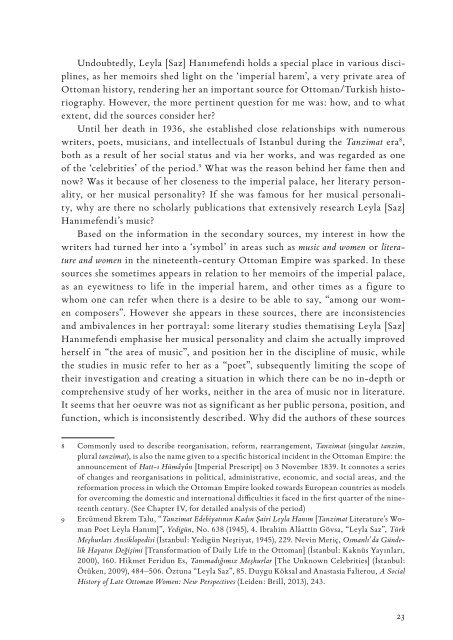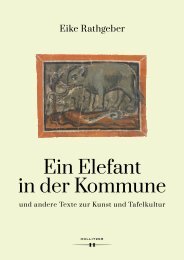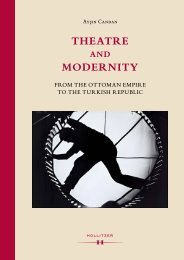You also want an ePaper? Increase the reach of your titles
YUMPU automatically turns print PDFs into web optimized ePapers that Google loves.
Undoubtedly, Leyla [Saz] Hanımefendi holds a special place in various disciplines,<br />
as her memoirs shed light on the ‘imperial harem’, a very private area of<br />
Ottoman history, rendering her an important source for Ottoman/Turkish historiography.<br />
However, the more pertinent question for me was: how, and to what<br />
extent, did the sources consider her?<br />
Until her death in 1936, she established close relationships with numerous<br />
writers, poets, musicians, and intellectuals of Istanbul during the Tanzimat era 8 ,<br />
both as a result of her social status and via her works, and was regarded as one<br />
of the ‘celebrities’ of the period. 9 What was the reason behind her fame then and<br />
now? Was it because of her closeness to the imperial palace, her literary personality,<br />
or her musical personality? If she was famous for her musical personality,<br />
why are there no scholarly publications that extensively research Leyla [Saz]<br />
Hanımefendi’s music?<br />
Based on the information in the secondary sources, my interest in how the<br />
writers had turned her into a ‘symbol’ in areas such as music and women or literature<br />
and women in the nineteenth-century Ottoman Empire was sparked. In these<br />
sources she sometimes appears in relation to her memoirs of the imperial palace,<br />
as an eyewitness to life in the imperial harem, and other times as a figure to<br />
whom one can refer when there is a desire to be able to say, “among our women<br />
composers”. However she appears in these sources, there are inconsistencies<br />
and ambivalences in her portrayal: some literary studies thematising Leyla [Saz]<br />
Hanımefendi emphasise her musical personality and claim she actually improved<br />
herself in “the area of music”, and position her in the discipline of music, while<br />
the studies in music refer to her as a “poet”, subsequently limiting the scope of<br />
their investigation and creating a situation in which there can be no in-depth or<br />
comprehensive study of her works, neither in the area of music nor in literature.<br />
It seems that her oeuvre was not as significant as her public persona, position, and<br />
function, which is inconsistently described. Why did the authors of these sources<br />
8 Commonly used to describe reorganisation, reform, rearrangement, Tanzimat (singular tanzim,<br />
plural tanzimat), is also the name given to a specific historical incident in the Ottoman Empire: the<br />
announcement of Hatt-ı Hümâyûn [Imperial Prescript] on 3 November 1839. It connotes a series<br />
of changes and reorganisations in political, administrative, economic, and social areas, and the<br />
reformation process in which the Ottoman Empire looked towards European countries as models<br />
for overcoming the domestic and international difficulties it faced in the first quarter of the nineteenth<br />
century. (See Chapter IV, for detailed analysis of the period)<br />
9 Ercümend Ekrem Talu, “Tanzimat Edebiyatının Kadın Şairi Leyla Hanım [Tanzimat Literature’s Woman<br />
Poet Leyla Hanım]”, Yedigün, No. 638 (1945), 4. Ibrahim Alâattin Gövsa, “Leyla Saz”, Türk<br />
Meşhurları Ansiklopedisi (İstanbul: Yedigün Neşriyat, 1945), 229. Nevin Meriç, Osmanlı’da Gündelik<br />
Hayatın Değişimi [Transformation of Daily Life in the Ottoman] (İstanbul: Kaknüs Yayınları,<br />
2000), 160. Hikmet Feridun Es, Tanımadığımız Meşhurlar [The Unknown Celebrities] (İstanbul:<br />
Ötüken, 2009), 484–506. Öztuna “Leyla Saz”, 85. Duygu Köksal and Anastasia Falierou, A Social<br />
History of Late Ottoman <strong>Women</strong>: New Perspectives (Leiden: Brill, 2013), 243.<br />
23














